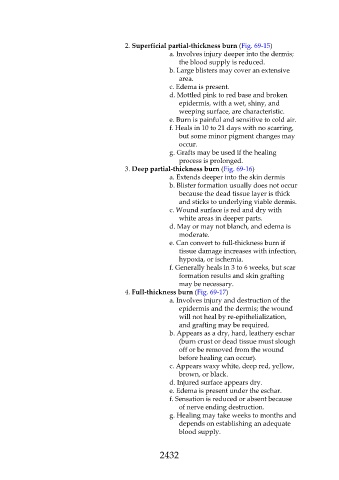Page 2432 - Saunders Comprehensive Review For NCLEX-RN
P. 2432
2. Superficial partial-thickness burn (Fig. 69-15)
a. Involves injury deeper into the dermis;
the blood supply is reduced.
b. Large blisters may cover an extensive
area.
c. Edema is present.
d. Mottled pink to red base and broken
epidermis, with a wet, shiny, and
weeping surface, are characteristic.
e. Burn is painful and sensitive to cold air.
f. Heals in 10 to 21 days with no scarring,
but some minor pigment changes may
occur.
g. Grafts may be used if the healing
process is prolonged.
3. Deep partial-thickness burn (Fig. 69-16)
a. Extends deeper into the skin dermis
b. Blister formation usually does not occur
because the dead tissue layer is thick
and sticks to underlying viable dermis.
c. Wound surface is red and dry with
white areas in deeper parts.
d. May or may not blanch, and edema is
moderate.
e. Can convert to full-thickness burn if
tissue damage increases with infection,
hypoxia, or ischemia.
f. Generally heals in 3 to 6 weeks, but scar
formation results and skin grafting
may be necessary.
4. Full-thickness burn (Fig. 69-17)
a. Involves injury and destruction of the
epidermis and the dermis; the wound
will not heal by re-epithelialization,
and grafting may be required.
b. Appears as a dry, hard, leathery eschar
(burn crust or dead tissue must slough
off or be removed from the wound
before healing can occur).
c. Appears waxy white, deep red, yellow,
brown, or black.
d. Injured surface appears dry.
e. Edema is present under the eschar.
f. Sensation is reduced or absent because
of nerve ending destruction.
g. Healing may take weeks to months and
depends on establishing an adequate
blood supply.
2432

